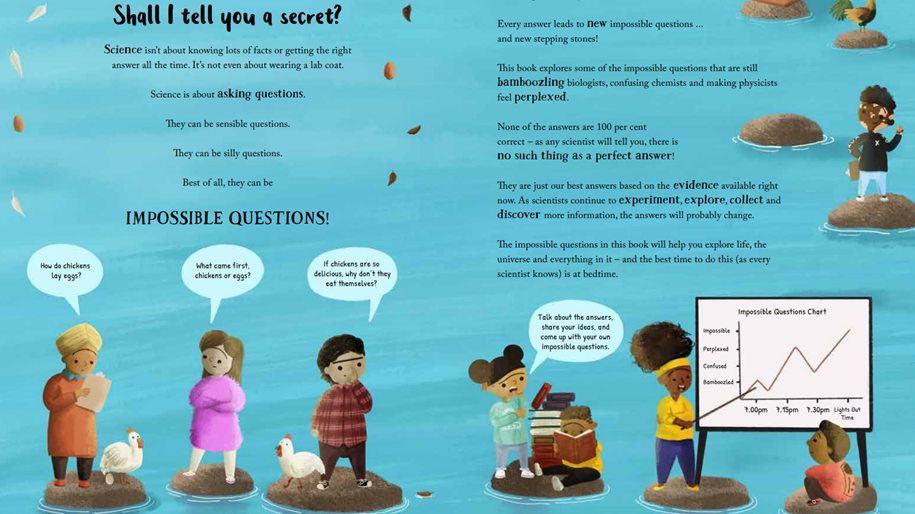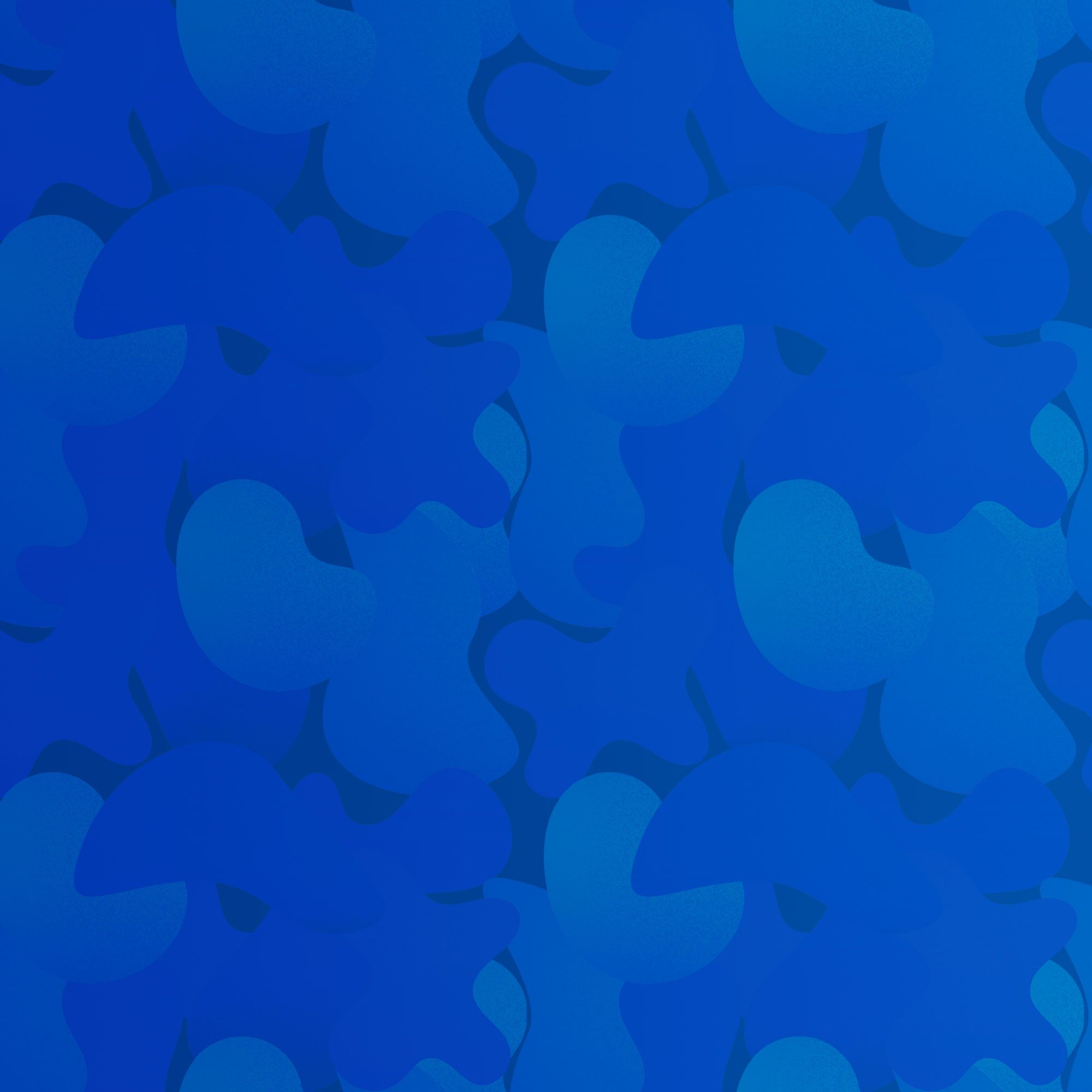Isabel Thomas


About Author
Isabel Thomas is a science writer and the author of a galaxy of books for young audiences, including Moth: An Evolution Story, illus Daniel Egnéus. She also writes for science magazines including The Week Junior and creates STEM outreach resources for the BBC. www.isabelthomas.co.uk
Aaron Cushley is a talented illustrator from Belfast who studied Illustration and Graphic design at the University Of Ulster. Aaron loves illustrating non fiction books and was shortlisted for the Information Book Award 2021 for How Many Mice Make an Elephant?, by Tracey Turner (Pan MacMillan).
Download an extract from The Bedtime Book of Impossible Questions
Interview
The Bedtime Book of Impossible Questions (Bloomsbury Children's Books)
October 2022
If there is a lot in the world that puzzles you, questions like can you touch a rainbow, or why don't humans have tails?, then you need The Bedtime Book of Impossible Questions, which holds the answers to lots of questions like these. Author Isabel Thomas has collected the questions from children themselves during her visits to schools around the country - and she decided to put them together in The Bedtime Book of Impossible Questions, so we can all find the answers to these and more questions!
Here is author Isabel Thomas to tell us more about The Book of Impossible Questions!
Isabel Thomas tells ReadingZone about writing non fiction and answering 'impossible questions':
1. Can you tell us about your path into writing, and why you focus on writing books about science for children and young people?
I studied Human Sciences at university but fell in love with writing as a student journalist. After university, I combined teaching science with working for a local company that published maths and science textbooks. I quickly realized I preferred writing books to the business side of things, so for eight years I wrote and pitched books in the evenings alongside my day job. Science is what I knew best, and loved best, so that focus came naturally. By 2010, I had built up a list of regular clients, and began writing full-time.
That sounds like a neat path into writing, of course it was anything but! I mentor other writers from low-income backgrounds and work with the Society of Authors to share what I have learned from tackling the obstacles to writers from non-traditional backgrounds. The same thing motivates all my writing and outreach work: to let young people know these fascinating careers and opportunities in science and writing are out there, and that they belong in these worlds, and to give them tools that will help them to pursue their dreams.
2. What inspired you to write your new book, The Bedtime Book of Impossible Questions - and why did you want to introduce it as bedtime reading?
The premise of the book - and the source of all creativity - is connections. The idea for this book came from three things that slowly melded themselves in my mind.
First, I've had the honour of visiting dozens of schools, meeting thousands of children and answering hundreds of questions. It's always my favourite part of a visit.
Second, I have three children of my own, and I have always delighted in the way they come up with imaginative questions to delay bedtime indefinitely… A few years ago, I saw a quote that summed it up perfectly - 'At bedtime, my child turns into a dehydrated philosopher in need of a hug!'
Third, I have always worked, through outreach and through writing, to demolish myths about science and who belongs in science. One of the most common misconceptions is that to be a scientist, you need to know lots of facts or get the right answers all the time. Science is not about this at all. It's about asking questions. They can be sensible questions. They can be silly questions. But best of all they can be impossible questions. It's the quest to answer impossible questions that leads to creativity, discovery, and breakthroughs.

3. What kinds of areas do you cover in the book? How is it organised?
The joy of this book is that it's unorganized! There are no chapters, no neat categorization into areas of science. This better reflects science itself - some questions are so huge in scope, we need research from multiple areas of science to even begin to explain them!
The book is more like a compendium of short stories that you can dip into at random or choose depending on your mood. Each answer is the perfect length to read at bedtime and written rather like a bedtime story too. It's a new approach to non-fiction and I hope that readers will love it!
4. How did you decide on the questions you wanted to ask?
Around ten years ago, I began collecting the best questions I heard, from assemblies (If chickens taste so good, why don't they eat themselves?), from school workshops (Where do new ideas come from?) and from virtual visits during lockdowns (Why do we need eyebrows?). I also collected questions my own children asked at bedtime (What's the opposite of a spider?).
Every question in the book comes from this collection, apart from one. Are cats liquid or solid? was asked - and answered - by a physicist called Marc Antoine-Fardin. I often use it in school assemblies to demonstrate the sheer joy of using science and mathematics to provide satisfying answers to bamboozling questions, so it had to have an honorary spot in the book!
5. You have been writing about science for some time now, but did you still need to research the answers?
Absolutely! Every time I speak to children and introduce myself as the author of 200+ books, I immediately tell them a secret. A secret that all science writers (and scientists) share. Nobody carries all this knowledge around in their head with them, and often I begin writing about a topic knowing nothing at all! However, with imaginative questions and diligent research, you really can find an answer to everything… To answer the 73 questions in this book, my footnotes tell me I consulted more than 500 sources!
6. What is your favourite question in the book?
THIS is an impossible question! Ok, I will be diplomatic and choose a question from one of my own children: If everything is made of atoms, are feelings made of atoms? This question perfectly captures the way that young children will absorb new information, ruminate for a bit, then absolutely dazzle with their creative connections.

7. Were there any questions that you couldn't answer, because they were too hard to explain?
There is one question that I've carried around on a Post-it® note since my eldest son was at nursery. It was stuck to his daily diary (which typically records nappy changes and snacks) and he'd asked, “If frogs lay eggs, where did the first frog come from?” Since then, I've been asked a version of this question by dozens of children, and I've spent ten years thinking about the best answer. Although it wouldn't fit in The Bedtime Book of Impossible Questions, I'm pleased to say Bloomsbury has commissioned an entire book of its own, which I'm writing right now!
However, I did not shy away from questions that are hard to explain. Everyone who knows children will know they don't shy away from difficult questions either. One moment they could be pondering the world's worst smell, or how long it would take to count to infinity, but the next they might stun you with something deeply philosophical. Why am I me and not someone else? Why can't I remember being a baby? Why don't we live forever? Why do I like my friends more than other people? My answers to all these questions are in the book.
8. How do you make the subjects you cover engaging for your readers?
I make them engaging for myself. I focus on the facts, connections, questions, and analogies that fill me with wonder and let my curiosity show me which way to go into a topic. I think about how an eight-year-old would talk about a topic they are passionate about, with unbridled wonder and joy.
9. What do you think of the look of the finished book, with illustrations by Aaron Cushley. Are there any spreads that stand out for you?
As soon as I saw the first illustrated spread (Can I swim in ice cream? / Are cats liquid or solid?) I knew that Aaron was the perfect illustrator for Impossible Questions. He delights in finding weird and wonderful connections and is skilled in thinking like an eight-year-old too! In his hands, every spread becomes a world of its own, sometimes surreal and always funny and fascinating. One of my absolute favourites is the spread of penguins playing with bubbles as they investigate how bubbles work, and why they are always round.

10. Other than some fascinating insights into our world, what would you like young readers to take from your book?
This book is for both young people and their adults, and I hope they will take away slightly different things. I'd love to leave children with the sense that curiosity is their superpower, and that there is power in saying 'I don't know… yet.” I'd love to encourage them to carrying on questioning everything around them.
Grown-ups can sometimes feel put on the spot by children's trickiest questions, so I'd love the book to reassure adults that you don't have to have the right answers in order to provide a brilliant answer to an impossible question. Simply talking about ideas together is enough, and shows children that their curiosity is something to celebrate.
So, I've dedicated the book to everyone who doesn't take 'I don't know' for an answer.
 The Bedtime Book of Impossible Questions
The Bedtime Book of Impossible Questions
